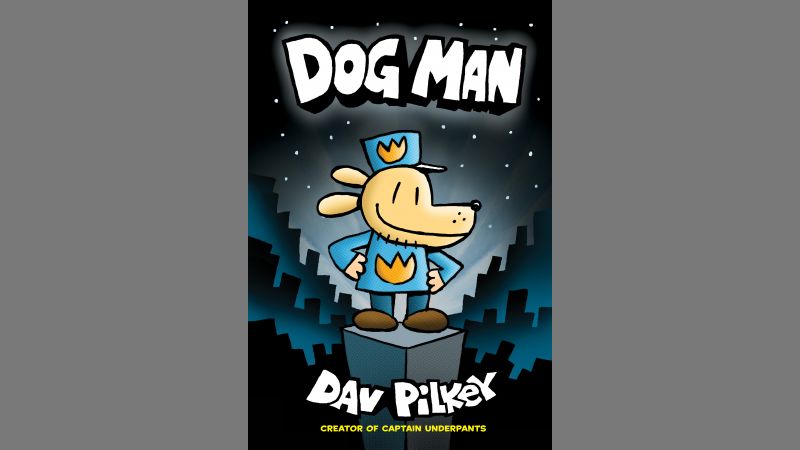Introducing Dog Man and Cat Kid Books
Dog Man and Cat Kid are popular children’s graphic novel series written and illustrated by author and cartoonist Dav Pilkey. The Dog Man books tell the adventures of the crime-fighting canine title character created when Officer Knight’s police dog Greg and his partner were injured in the line of duty and had to be surgically fused together. The Cat Kid series features Li’l Petey, Dog Man’s comic book creating sidekick, and his own cast of cat characters.

Both Dog Man and Cat Kid books employ Pilkey’s trademark style combining comic panels with short passages of text in a highly visual storytelling format perfect for engaging young readers. The series are bestsellers, appearing on children’s graphic novel bestseller lists and appealing to kids ages 7-10 with their stories of silly antics, fart jokes, crime fighting and unlikely animal heroes.
About the Author – Dav Pilkey
The Dog Man and Cat Kid series were created by the American author and illustrator Dav Pilkey. As described on his official website (https://pilkey.com/author), Pilkey struggled with ADHD and dyslexia as a child and was disruptive in class as a result. His teachers had him sit outside in the hallway each day. Pilkey used this time to create his own comics to entertain himself, sparking his career and passion for cartooning and children’s books.

Pilkey is best known as the creator of the Captain Underpants book series, published beginning in 1997. Building on this success, he debuted the Dog Man series in 2016, featuring a part-dog, part-man crimefighting hero. The spinoff Cat Kid comic series followed in 2017, which centers on Petey, Dog Man’s feline sidekick. Pilkey’s books are well-regarded for their appeal to reluctant readers and kids with conditions like dyslexia, given their heavy use of illustrations, humor, and engaging stories.
Reading Levels Explained
There are several different reading level systems used in education to assess a student’s reading ability and match them with appropriate books. Some of the most common reading level systems include Guided Reading Level (GRL), Developmental Reading Assessment (DRA) and Lexile Measures.
The Guided Reading Level system is used for leveling early readers from kindergarten to grade 3. Books are assigned a letter ranging from A to Z, indicating progression from easiest to most challenging. The DRA system uses a numerical scale from 1 to 80 to measure a student’s reading engagement, oral reading fluency, and comprehension. The Lexile system uses a measure ranging from below 200L for early readers to above 1600L for advanced readers. Lexile levels indicate the reading demand or text complexity of books.
These reading level systems help match students to books at an appropriate difficulty level. Educators use reading levels to guide reading instruction and help students improve their skills. When selecting books, it’s important to consider a child’s interests and reading level to find engaging material they can read independently.
Assessing Reading Levels
Reading levels are determined based on various factors that measure a student’s reading abilities and comprehension. Some key components for assessing reading levels include vocabulary, sentence length and structure, text complexity, themes and content, and more.
Students are often formally assessed through reading inventories or benchmark assessments. These tools look at a student’s familiarity with words used in the text, their fluency and accuracy when reading aloud, and their ability to comprehend and retell key ideas. Books are then leveled based on quantitative measures of vocabulary, sentence length, and text complexity as well as qualitative factors like content and themes.
Lower reading levels use simple vocabulary, short sentences, and minimal story complexity. As students progress to higher reading levels, they encounter more advanced vocabulary, longer descriptive sentences, and more sophisticated themes and literary devices. Assessing a student’s independent, instructional, and frustration levels helps teachers identify materials that scaffold learning and provide an appropriate challenge.
Dog Man Reading Level
Based on various reading level assessments, the Dog Man books by Dav Pilkey are generally considered to be at a second to third grade reading level. The books have a Guided Reading Level of P-S, which corresponds to grades 2-3. The Lexile level ranges from 420L to 500L, appropriate for ages 7-9 years old. According to the Fountas and Pinnell benchmark assessment, the Dog Man books are around a level M or N, which is a mid to late second grade reading level.

Overall, the Dog Man series is recommended for ages 7-10 and grades 2-5. The vocabulary, sentence length and complexity, themes, and content are appropriately challenging and engaging for young elementary school students in this age range.
Cat Kid Reading Level
The Cat Kid books by Dav Pilkey are generally assessed to be around a 2nd to 5th grade reading level, depending on the specific book and assessment used.
According to Scholastic, the Cat Kid Comic Club book has a Guided Reading Level of GR Level S and a DRA Level of 40-50. The company Penworthy lists the book at a reading level of 2.9.
So according to common leveling systems, the first Cat Kid Comic Club book is approximately a 2nd to 5th grade level. Other books in the series are likely to have a similar reading level. The graphic novel format, focusing on illustrations and humor, help make these books appealing and comprehendible for young readers.
Appropriate Age Range
The Dog Man and Cat Kid books by Dav Pilkey are generally aimed at ages 7-10, though they can appeal to slightly younger and older readers as well. They are marketed as early chapter books and have a second or third grade reading level according to most assessments.
Scholastic, the publisher of the Dog Man series, recommends the books for ages 7-10. The books feature simple vocabulary and sentence structure appropriate for this age group. The graphic novel format with abundant illustrations also appeals to developing readers in elementary school.
Common Sense Media agrees the books are best suited for ages 7 and up, though some kids as young as 5 enjoy them. They note the books have cartoon violence and rude humor that make them inappropriate for very young readers. The content is generally suitable for most ages 7-12.
Overall, the sweet spot seems to be ages 7-10 for independent reading. However, the Dog Man books can be read aloud to younger kids and provide engaging, funny content for pre-readers as well. Older or advanced readers may still enjoy the humor and stories into ages 11-12 and beyond.
Vocabulary and Content
The Dog Man books by Dav Pilkey use age-appropriate vocabulary and themes that appeal to young readers. The books contain simple words that early elementary school students can read and understand, with more advanced vocabulary mixed in to expand children’s knowledge. According to analysis on Teachers Pay Teachers, common vocabulary words in Dog Man and Cat Kid include “evil,” “menace,” “mayhem,” “sinister,” and “rampage” (source). These words are usually accompanied by illustrations that help convey the meaning.
The Dog Man books explore themes of friendship, teamwork, and using one’s powers for good instead of evil. The stories are told with humor and imagination to engage young readers. As this summary describes, Dog Man and Cat Kid involves themes of jealousy and learning to work together. The content resonates with children’s experiences and presents positive messages.
Appeal for Young Readers
The Dog Man and Cat Kid books have become enormously popular with young readers, especially those around the ages of 7-10. There are several reasons kids are drawn to these graphic novel adventures:

The stories feature relatable characters like Dog Man, a part-dog, part-man superhero, and his sidekick Cat Kid. The hilarious dialogue and funny scenarios hook readers right away. As Kirkus Reviews notes, “Pilkey’s graphic novel is chock-full of his signature silliness and toilet humor.”
The books also have kid-friendly themes about friendship, teamwork, and conquering fears. The exaggerated comic book art style appeals to young readers’ visual sensibilities. Short sentences and simple vocabulary make the books accessible for emerging readers. At the same time, the stories are clever enough to engage kids at higher reading levels.
Overall, the Dog Man and Cat Kid series expertly balances humor, adventure, and relatable characters that young readers love. As a result, the books fly off library and bookstore shelves.
Conclusion
In summary, the Dog Man and Cat Kid book series by Dav Pilkey are generally considered to be at a second to third grade reading level. These hilarious graphic novels use simple vocabulary, short sentences, large text, and colorful pictures to appeal to young readers ages 6 to 9. While their reading level is low, the content remains engaging and amusing for kids, featuring outrageous characters, funny dialogue, and lots of potty humor. For early elementary school students just starting to read chapter books independently, the Dog Man and Cat Kid series are excellent options that will encourage reading practice and a love of books.